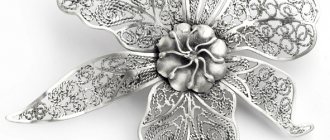The famous Ipatiev Chronicle brings to us the story of the marvelous creations of Russian jewelers who decorated their products with enamel - a composition of colored glassy powder hardened after firing, which made it possible to achieve an extraordinary visual effect. This technology came to Rus' from Byzantium, where it appeared in the 6th century. Nowadays, the ancient word enamel has gone out of circulation, giving way to the currently used term - artistic enamel.
What is decorative enamel?
Before we start talking about what the artistic technique called “cloisonne enamel” is, let’s take a closer look at the description of this composition itself, used by jewelers and masters of decorative and applied arts. As mentioned above, enamel is a powder obtained by grinding colored glassy plates.
Moistened with water and transformed into a solid, pliable mass, the composition is applied to cells made on the surface of the product. The next stage of work is firing. It is produced either in a furnace or with a special gas or gasoline burner. Under the influence of high temperature (from 700 to 900 °C), the glassy mass hardens and takes on its unique appearance.
Features of working with enamel
Depending on the composition of the crushed glassy mass, the temperature, and the duration of firing, the resulting enamel can have varying degrees of transparency or be completely opaque - dull. This opens up wide creative possibilities for the master, as it allows him to achieve a wide variety of effects.
The range of techniques used in works of this kind is very rich, and one of them is cloisonné enamel. Jewelry made using it is not widespread and is considered elite. The reason is the complexity of their manufacture and the impossibility of mechanizing the production process. Each item is a unique work of authorship. If we also consider that noble metals are often used in work, their high price and low availability become clear.
How is cloisonne enamel created?
First of all, on the gold, silver or cupronickel (less often copper or steel) surface, which is the basis of the composition, the outline of the future design is engraved, and sometimes cut through. Then metal partitions are soldered along its edges, the thickness of which rarely exceeds one millimeter. These partitions, which give the name to the described type of enamel technique, form both closed and open cells, which are filled with a still liquid and viscous multi-colored mass.
After the enamel hardens during the firing process, the product is ground and polished. This is done in such a way that the surface of the partitions and enamel creates a single plane. The technique of cloisonné enamel is significantly complicated by the fact that during firing the layer of material shrinks and becomes lower than the partition. As a result, you have to replenish the cells and re-fire the product. Depending on a number of technical factors and the artistic intention of the author, firing can be repeated from five to one hundred times.
Unique products and consumer goods
It should be noted that the inability to influence the processes occurring in enamel when exposed to high temperatures determines the originality and uniqueness of each product. It is almost impossible to achieve the same effect twice, so each piece made using this technique is unique.
Cloisonné enamel is not the only enamel technique in the arts and crafts. Along with it, the so-called excavation is also widely used. It differs from the septal one in that the glassy composition is filled not with the cells formed by soldered partitions, but with specially made recesses, the shape of which corresponds to the lines of the drawing. In modern jewelry production, stamped blanks or those made by casting are usually used for this purpose. In the same industry, imitation cloisonné enamel is also used in the manufacture of consumer goods.
The art of enamel in the 16th century
In the 16th century, under Ivan IV the Terrible and Boris Godunov, skilled jewelers from different parts of the Russian land created items in the Kremlin workshops that decorated court life.
Gospel of Ivan the Terrible 1571
In 1571, Ivan the Terrible was preparing for his wedding to Marfa Sobakina. Then he ordered the Kremlin jewelers to fulfill the Gospel and donated it to the Annunciation Cathedral. The cover of the book is decorated with chased medallions, large precious stones, and an elegant filigree pattern made of thin gold wire is filled with enamel. Its exquisite color scheme is based on a combination of delicate, light tones: white, green and extremely rich in shades of blue - from intense cornflower blue, turquoise to lilac. Golden droplets of greenery fused into the enamel froze like sparkling splashes on the ornament.
Gospel of Ivan the Terrible.1571
Stained glass window effect
Cloisonne enamel also has one more variety. It is called stained glass or window enamel. This technique is characterized by the fact that it does not use a metal base. It got its name because the products made on its basis resemble stained glass windows in appearance. They are completely transparent, and light, penetrating through the glassy mass, creates the illusion of colored stained glass framed by metal.
Products made using this technique are extremely beautiful. The metal frame, filled with enamel, looks like fine lace made of gold, silver or copper. It is made by sawing or mounting and then soldering parts made from wire twisted in a special way. Colored enamel filling the gaps between the partitions creates an indescribable play of light.
18th century enamel miniatures
The creativity of the masters of this century, in particular those from Solvychegodsk, prepared the way for the appearance of enamel miniatures in the 18th century. Among her genres, portraits predominated, and not by chance. The Petrine era affirmed the importance of the human personality. At this time, a national school of portrait painting began to form.
Miniatures were made on copper, silver and gold. The metal plate was covered with a layer of plain, usually white enamel and fired several times until it became even and smooth. The applied painting was covered with fondon - a transparent glassy mass that protects the painting from scratches. And the reverse side of the plate was necessarily filled with counter-enamel, otherwise cracks could form on the surface due to uneven cooling of the metal and enamel. When painting, the enamel artist used the dotted technique: he applied paint with dotted touches of the brush. This made it possible to convey the finest color nuances and light and shade.
Enamel artist G.S. Musikiysky
The creator of Russian portrait miniatures in enamel is Grigory Semyonovich Musikiysky. It is known that in 1710 he was listed as a painter at the Armory Chamber, and a few years later he was named in documents as a “master of enamel.” Many of his works have survived. Among them, portraits of Peter I, his wife Catherine I, their children, and Prince Menshikov predominate. Enamellers never painted from life, but repeated well-known paintings. The State Hermitage Museum houses a portrait of Peter I by Musikiski, based on an original by the famous artist Jan Kupetsky. Peter is depicted as a statesman-transformer against the backdrop of the new northern capital he founded and the Russian fleet. Beautiful color scheme: pure azure and crimson-red tones in combination with dark armor and white ermine mentia create a rich color scheme.
Musikiysky G. S. Portrait of Peter I. 1720
Application
In the 18th century, enamel miniatures were inserted into rings, medallions, bracelets, placed on snuff boxes, and used to decorate religious objects. And if in the middle of the century enamel was bright and rich, then later it was replaced by two-color, made in white-gray or white-blue tones - the so-called grisaille.
Jewelers also invented new decorative techniques. The craftsmen of Veliky Ustyug covered the surface of copper dishes, goblets, and cups with plain enamel and fused silver relief overlays into it, which were cast in special matrices. These could be bouquets of flowers, all kinds of coats of arms, ladies and gentlemen in magnificent costumes, mythological scenes and landscapes, and even entire cities and fortresses. On a white, blue, dark blue, turquoise background, the images looked elegant.
Cup. Veliky Ustyug. end of 17th century
Guilloche
In the last quarter of the 18th century, guilloché enamel was widespread. An ornament in the form of rays, stars, concentric circles, zigzags was applied to the surface of the metal, and the top was covered with transparent enamel. And it sparkled so much that it could compete with the brilliance of precious stones. Jewelers used this technique to create elegant snuff boxes, which then became fashionable and became an integral part of the costume.
Snuff box with replaceable decor. Guilloche enamel.1760s
Traditions of Chinese enamel
Chinese enamel occupies a special place in the history of decorative and applied arts. Cloisonne enamel, called clausane, was not an invention of the Chinese themselves, but came to them from France, but received a unique development due to local national traditions. From its original source, it inherited mainly the name, which comes from the distorted French word Cloison - “partition”. Before the appearance of this type of enamel technique in China, a recessed version of it was used.
The Beijing Palace Museum exhibits a wide variety of works of decorative and applied art, among which Chinese enamel stands out. Cloisonne enamel is represented mainly by products of the 15th century from the Xuande and Jingtai periods. This is no coincidence, since the period of the Ming dynasty, to which the mentioned rulers belonged, is considered the time of the greatest flowering of this field of art. Based on their own technologies, as well as those borrowed from Europe, Chinese craftsmen with extraordinary imagination decorated table and floor vases, cups, candy dishes, as well as a variety of lamps.
Artistic enamel from Georgia
Georgian cloisonné enamel is also held in special esteem by collectors and simply art lovers. Its earliest known examples date back to the 9th century, and they were made using the same technology that is used today. The art of Georgia, which is distinguished by its unique flavor and inexhaustible energy, embodies many European and Eastern traditions. That is why cloisonne enamel, the technology of which came to these parts from Western Europe, fit so organically into it. Here it was not only mastered, but also received further development, thanks to which many masterpieces of the national Georgian school appeared.
Review
The development of Byzantine enamel art dates back to the 6th–12th centuries. The Byzantines perfected a form of enameling called cloisonné, where stripes of gold are soldered to a metal baseplate making the outline of the image. The recessed spaces between the gold filigree wire are then filled with colored glass paste or flux, which fills the negative space in the design with any color chosen. Byzantine enamels usually depict the person of interest, often a member of the imperial family or a Christian icon. Enamels, because they are created from expensive materials such as gold, are often very small. They are sometimes made into medallions to serve as decorative pieces or to adorn ecclesiastical decorations such as book covers, liturgical equipment such as chalice and paten, or in some cases royal crowns. Collections of small enamels can be brought together to create a large narrative display, such as in the Pala d'Oro altarpiece.
Many examples of Byzantine enamel known today were reworked into new settings, making dating particularly difficult where inscriptions or identifiable faces are not visible. The Latin Crusaders, who sacked Constantinople in 1204, took many examples of Byzantine enamel from their return to the west. The destruction of Constantinople meant that the production of enamel art declined in the 13th century. It is possible that many of the examples left in the city were melted down and repurposed by the Ottoman Empire, which cared little about the religious significance of the art and may have reused gold but not glass.
Enamel in times past and today
It is known that cloisonne enamel masters of past centuries used different components than their modern followers to obtain the composition they needed. One of the old recipes says that to prepare enamel you need one part of pure quartz sand, one part of boric acid and two parts of red lead. To give the composition the desired color, various pigments were used in the form of cadmium, cobalt or copper oxides.
In the 20th century, the enamel technique went beyond its traditional use and, in addition to decorative and applied arts, began to be used wherever it was necessary to create a durable and chemically resistant surface. Technical enamels appeared. Accordingly, the technology of their preparation has also changed.
Problems with dating and provenance
Many examples of Byzantine enamel are difficult to date due to the lack of an inscription or identification. In these cases, it is necessary to guess the date of the object in question by comparison with similar objects with known dates. This can be done by researching material sources and comparing styles. For example, objects with green glass made of similar material may be grouped together in the same date range. The origins of Byzantine enamel are often even more difficult to determine, since almost everything produced was kept in the West since the early 13th century. One way to guess the origin of a work is to check the quality of the Greek letters; the more precise the Greek, the more likely it is that the work came directly from the Byzantine Empire.
Cloisonne enamel: master class
At the end of the article, we provide a detailed story on how to make a panel yourself, made using the septum enamel technique. This unique master class will allow everyone to try their hand at creating a work of decorative and applied art.
First of all, you need to take a copper plate of suitable size and thickness and anneal it until it turns red, and then cool it in water. This will give the material softness and protect it from deformation during further firing of the enamel itself. After this, the plate is wiped and thoroughly cleaned with sandpaper. You should not achieve a perfectly smooth surface, since slight roughness will contribute to a better connection between the metal and the enamel.
From drawing to installing partitions
The next step is to apply a design to the plate. This can be either your own composition or transferred from a book using tracing paper and carbon paper. To make the image clearer, the plate can be pre-coated with white gouache. Once the design is marked, it should be scratched using a steel scribe used in metalwork. After this, the plate is thoroughly washed and calcined again over fire.
To make partitions, it is recommended to use copper wire with a diameter of approximately 0.8 millimeters. It is first passed through rollers or simply flattened with a hammer. The resulting strip is glued edgewise to the plate, exactly repeating the line of the drawing. For this work, alcohol glue BF-6 is usually used.
Enameling and firing
To make panels, enamel should be used in the form of a powder mass. There are varieties on sale with the addition of gold or silver particles, which gives the product a more expensive and sophisticated look. The powder is diluted with water and the resulting mass is filled with the gaps between the partitions. For this purpose it is convenient to use a spatula and a brush. It is important that the enamel layer is evenly laid exactly along the height of the partitions.
The next step will require a drying oven. In it, the product is dried at a temperature of 60 ° C until the water completely evaporates from the enamel mixture. Upon completion of this process, the plate on a heat-resistant steel stand is placed in a muffle furnace and fired. If it is possible to regulate the temperature in the oven, then it is advisable to bring it to 850 ° C; if not, then heating should be continued until the surface of the product becomes glossy.
Fixing enamel on products occurs in different ways - hot and cold.
HOT ENAMELS
Modern hot enamels are a favorite in enamel jewelry. The enamel is baked to the metal in muffle furnaces at a temperature of 600-800C. The product is then cooled and polished.










